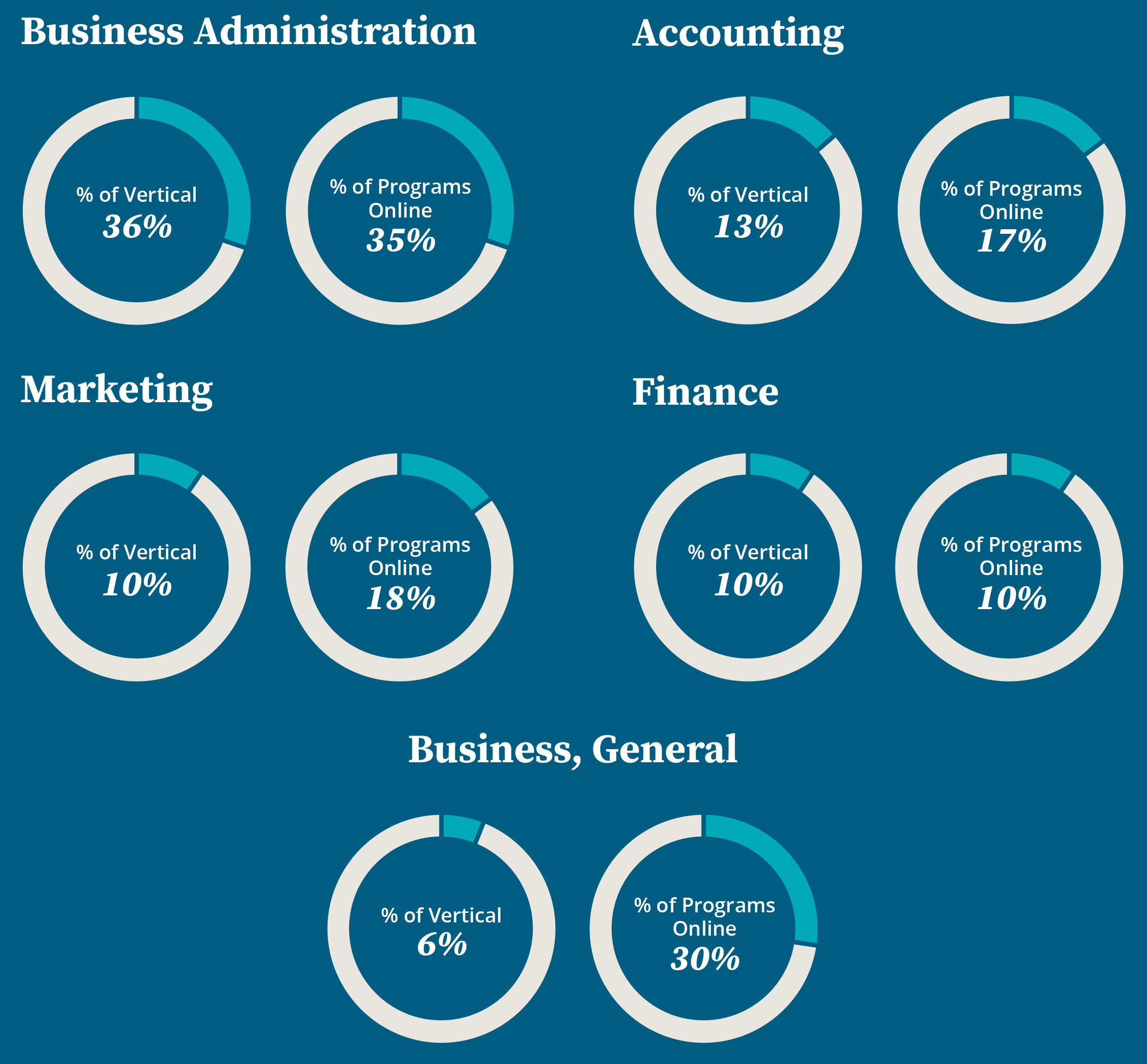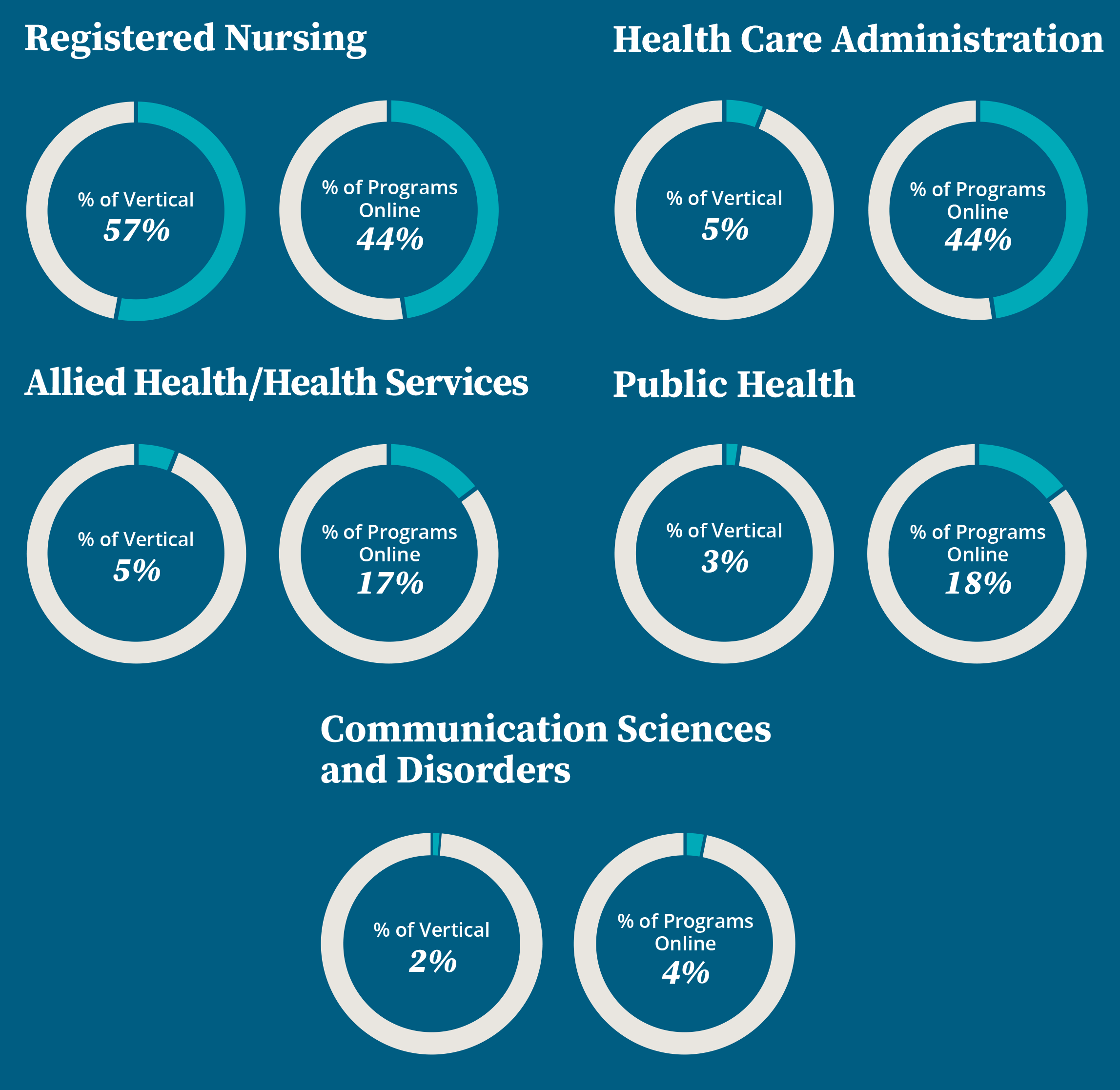The Bachelor’s Education Market:
Trends and Insights in Key Disciplines

Unwavering momentum:
The bachelor’s education market has grown by a brisk 22% since 2010.
While universities need to understand opportunities for developing a dynamic program portfolio, they should also be aware of disciplines that are on the decline.
Based on the latest data from the 2018/2019 academic year, here’s a snapshot of the four largest undergraduate verticals and programs within them to watch.
Business
There’s no stopping it. Business has been the leading undergraduate vertical for the last two decades, and with 4% year-over-year growth since 2014, it shows no signs of slowing down.
The Largest Business Programs and Their Online Presence
Biggest vertical. Biggest programs. The five largest business programs combined accounted for 75% of all undergraduate business disciplines, with 22% of all business bachelor degree programs available online. The biggest of these, the Bachelor of Business Administration (BBA), constituted over one-third of the entire business vertical alone and is the degree with the most online availability.


Business: Opportunities for Growth vs. Programs at Risk
Grown the Most Since 2014:
- Insurance
- Management Science
- Organizational Leadership
- Real Estate
- Supply Chain Management
Declined the Most Since 2014:
- Accounting and Business/Management
- Administration/Management
- Hospitality
- Hotel/Motel Administration/Management
- Human Resources Management
- Organizational Behavior Studies

Health
Health may take second place to business in the undergraduate education market, but it is certainly thriving. Overall, health programs have grown 5% year-over-year since 2014.
The Largest Health Programs and Their Online Presence
Registered nursing (RN-BSN) is the bedrock of the health field. This giant accounted for more than half (57%) of all bachelor’s-level health degrees, with 44% of those programs offered online. By comparison, the next four largest degrees make up just 15% of the vertical combined. Twenty-five percent of all health degrees are online, a significant reason why this vertical is so successful.


Health: Opportunities for Growth vs. Programs at Risk
Grown the Most Since 2014:
- Allied Health/Health Services
- Community Health and Preventative Medicine
- Health and Wellness
- Health Services Administration
- Public Health
Declined the Most Since 2014:
- Dietetics
- Hospital and Health Care Facilities Management
- Nursing Practice
- Occupational Therapy

Engineering
The rise of this star verges on meteoric. Although it ranks third in terms of vertical size, it is first in growth among the fields represented here, rising 34% since 2014.
The Largest Engineering Programs and Their Online Presence
Engineering defies the norm. Typically, growth this quick goes hand-in-hand with robust online adoption. However, only 4% of all engineering programs are available online. The five largest degrees here are more evenly sized than in other verticals. The largest program, mechanical engineering, makes up 25% of the greater field, while the remaining four account for 6-12%, respectively.


Engineering: Opportunities for Growth vs. Programs at Risk
Grown the Most Since 2014:
- Computer Engineering
- Computer Software Engineering
- Construction Engineering Technology
- Engineering Management
- Mechanical Engineering
Declined the Most Since 2014:
- Civil Engineering Technology
- Communications Engineering Technology

Social Sciences
Unlike psychology and its focus on cognitive and emotional activity, this vertical centers on studying social systems. A few programs are on the rise, but the overall field is in need of revitalization. Since 2014, this vertical has decreased overall by 3%.
The Largest Social Sciences Programs and Their Online Presence
Accounting for 64% of the vertical combined, political science, sociology, and economics dominate this field. Technically, the percentage of programs available online has doubled since 2012, but online adoption is still relatively low, with only 6% of programs offered in an online format.


Social Sciences: Opportunities for Growth vs. Programs at Risk
Grown the Most Since 2014:
- Criminology
- Economics and Quantitative Ecometrics
- Geographic Information Science and Cartography
Declined the Most Since 2014:
- Anthropology
- Economics
- Geography
- Social Sciences (General)

Wiley Education Services provides in-depth analytics to help universities enhance course offerings, evaluate new programs, and sync portfolios with learners’ needs.
For deeper insights, download the full report: State of the Education Market: Trends and Insights in Key Bachelor’s Disciplines.
This content is sponsored and written by Wiley Education Services.
The editorial staff of Inside Higher Ed had no role in its preparation.


